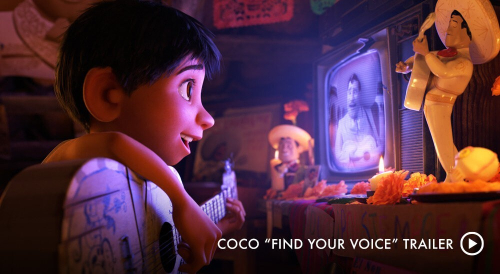
Coco review



Coco
Animated films have always been a cherished medium for storytelling, and Pixar's "Coco" exemplifies why they continue to hold a special place in audiences’ hearts. Released in 2017, "Coco" delves into the cultural richness of Mexico, entwining its narrative with a tradition that celebrates life and honors those who have passed on. As someone who's watched countless animated features, "Coco" stands out uniquely, not only by virtue of its distinctive cultural depiction but also because of its profound exploration of legacy and memory.
From the moment I pressed play, I was captivated by "Coco's" vibrant opening sequence. The animation studio didn't merely animate a story; they infused it with the soul and spirit of Mexican traditions. The meticulous details, from the bustling streets lined with papel picado to the heartfelt sound of mariachi music, instantly transported me to a world where the past and present elegantly dance to a harmonious rhythm. "Coco" is not just a film; it is an experience crafted intricately to touch both heart and spirit.
The Intriguing Backdrop: Setting the Stage
The narrative orbits around the imminent celebration of the Day of the Dead, or Día de los Muertos, a colorful festival that invites familial spirits back from the beyond. Miguel, an ardent music enthusiast, finds himself at odds with his family's ancestral ban on music. This clash of interests is portrayed against a canvas rich with the hues of tradition and the enchanting mystique of the afterlife.
It's fascinating that Pixar chose this particular cultural touchstone. Día de los Muertos, a familiar yet esoteric celebration for many viewers outside of Mexico, provides a potent vessel for storytelling. It begs the audience to reflect on how we honor our ancestors, a sentiment that resonates universally. This perspective is the beating heart of the narrative that unites various elements into a cohesive emotional journey.
A Historical Perspective
Diving into the film’s historical approach, "Coco" offers not just an escape but a lens into a rich cultural tapestry. The creators embarked on extensive research trips to Mexico, immersing themselves in the customs, music, and art integral to the Day of the Dead celebrations. This dedication is evident in the honest portrayal of Mexican life; each scene is saturated with authenticity and respect.
Moreover, the Land of the Dead, as depicted in "Coco," draws inspiration from various traditional and modern Mexican art forms, creating a visually stunning landscape that pays homage to the country's artistic heritage. The film bridges a cultural gap, enlightening audiences about the Day of the Dead beyond its aesthetic allure, inviting introspection about familial bonds and remembrance.
Why "Coco" Resonates Deeply
What struck me most about "Coco" was its profound message wrapped up in an accessible family film. It addresses themes of identity, tradition, and the quest to belong without resorting to simple platitudes. Miguel's journey is emblematic of anyone who has ever felt the tug between pursuing personal dreams and adhering to familial expectations. This universal theme is where "Coco" shines brightest, making it relatable across cultures and ages.
Notably, the film's treatment of memory as a living, breathing thing is compelling. The idea that people continue to exist as long as they are remembered resonates on a deep emotional level. This thematic depth is what elevates "Coco" from a mere animated feature to a conversation starter about our connections with those who came before us.
My Personal Impressions
As I watched "Coco," I found myself swept away by its confluence of visual splendor and heartfelt narrative. Each character, from Miguel to the vibrant skeletons of the underworld, was beautifully fleshed out, illustrating Pixar's dedication to character development. The passion and energy of Miguel's character, voiced by Anthony Gonzalez, leaps off the screen, pulling the audience along his captivating journey.
Equally impressive is the film’s score, composed by Michael Giacchino, which feels like a character of its own. Music, an integral theme in "Coco," is expertly woven throughout, connecting cultural elements to Miguel’s personal journey. The songs, especially "Remember Me," hold layers of meaning that evolve from scene to scene, culminating in a powerful finale that left an indelible mark on my heart.
The Animation: A Feast for the Eyes
Pixar is renowned for its animation prowess, and "Coco" is a testament to their ever-evolving expertise. The color palette is a visual symphony, capturing the vibrancy of life and the spectral beauty of the afterlife. It's extraordinary how every frame is meticulously composed, serving both the narrative and the cultural richness it seeks to convey.
The contrast between the Land of the Living and the Land of the Dead is particularly striking. While the former is depicted in warm, earthy tones reflecting familial warmth, the latter is an explosion of colors, a celebration of life after life. This animated dichotomy not only tells a story of its own but also complements the film's exploration of duality in life and the afterlife.
The Characters: Beyond the Protagonists
While Miguel undoubtedly steals the show, the supporting characters in "Coco" bring added depth and richness to the story. Héctor, Miguel’s partner in his quest, offers a mix of humor and poignancy, grounding Miguel's fantastical journey with personal stakes and emotional resonance. His multifaceted character arc adds layers to the film, reinforcing its message about memory and legacy.
In the same breath, other characters, such as the venerable Mamá Coco, serve as critical links to the past, grounding the narrative with emotional truth. Her presence is subtle yet profound, reminding viewers of the quiet but potent influence of familial elders. Each character is crafted with care, their stories intertwining to form a tapestry reflective of family dynamics and traditions.
Tackling Cultural Representations
In an era where cultural representation in media is scrutinized, "Coco" sets a high standard. It is a love letter to Mexican culture, meticulously representing its traditions, music, and values. What resonates is the creators' commitment to authenticity, engaging cultural consultants to ensure respectful and accurate portrayals. It's a film that celebrates diversity while inviting understanding and appreciation.
The art direction meticulously incorporates cultural motifs and symbols, enhancing viewers' understanding and appreciation of Mexican heritage. This approach is not just artistic but educational, encouraging audiences to delve deeper into the culture from which "Coco’s" narrative springs forth.
A Family Affair: Intergenerational Dialogues
One of the most compelling aspects of "Coco" lies in its portrayal of family dynamics. It is a dialogue between generations, a narrative that highlights the importance of understanding and compromise. The film balances humor with heartfelt moments, capturing the essence of family life with authenticity and warmth.
The tensions between Miguel and his family reflect real-life struggles within households where tradition clashes with modern aspirations. These interactions invite viewers to engage in conversations about heritage, ambition, and understanding, making "Coco" not just entertainment but a catalyst for meaningful dialogue.
The Emotional Core: Bridging Worlds
"Coco" excels in establishing an emotional core that bridges the worlds of the living and the dead. This narrative choice reinforces the film's central themes, offering a perspective of life that values past, present, and future simultaneously. It's a poignant reminder of the connections that bind us beyond physical existence.
What truly moved me was the film's ability to convey profound truths with simplicity. It presents an afterlife where love and memory are paramount, offering comfort and reflection. The film’s heartfelt messages echo long after the credits roll, speaking to individuals across different cultures and stages of life.
Memorable Musical Moments
Music serves as both a thematic and narrative catalyst in "Coco." It is Miguel’s passion, his defiance, and ultimately his salvation. Each musical number is carefully crafted to advance the plot and develop characters, making the soundtrack integral to the story’s emotional resonance.
With songs imbued with cultural significance and personal meaning, the music of "Coco" underscores the narrative’s emotional peaks and valleys. Notably, "Remember Me" evolves from a seemingly innocent lullaby to an anthem of memory and love, culminating in one of the film’s most touching scenes.
The Visual Spectacle of the Afterlife
The Land of the Dead, as animated in “Coco,” is a visual marvel that leaves a lasting impression. It is a vibrant metropolis alive with the movements of dancing skeletons and their whimsical lives beyond death. This imaginative portrayal balances the film’s serious themes with levity and creativity.
Exploring this lively afterworld, the audience is treated to a feast of visual storytelling. The creators envision an afterlife that bursts with color and life, challenging traditional notions of death with a perspective that celebrates continuity and remembrance.
Storytelling at Its Best
Beyond its aesthetic merits, "Coco" stands out through masterful storytelling. The narrative weaves together various threads—family, memory, music—into a cohesive whole, skillfully wrapped within the framework of a quest. Miguel’s journey is both personal and universal, inviting empathy and introspection.
The script paces itself beautifully, never lingering too long in one place, and ensuring a balance between action and emotional moments. This tight storytelling ensures that every scene contributes meaningfully to Miguel’s growth and the film’s overarching message about legacy and remembrance.
A Universal Message Wrapped in a Local Tale
At its core, "Coco" tells a quintessentially human story through a culturally specific lens. It speaks to the universality of love, memory, and the yearning to connect with our roots. Despite its setting in a particular context, it invites viewers from all backgrounds to explore and cherish the connections that define us.
This universal appeal is rooted in the film’s earnest depiction of emotions and motivations. It beautifully balances personal stories with wider cultural narratives, making it not only a Mexican tale but a tale of humanity—a narrative that resonates across geographical and cultural boundaries.
The Cultural Legacy of Coco
Since its release, "Coco" has had a resounding impact on audiences and critics alike. Its box office success and critical acclaim underscore not only Pixar’s storytelling prowess but also the appetite for diverse narratives that challenge and inspire. It has brought broader attention to visually represented Mexican traditions and storytelling in global cinema.
More than just entertainment, "Coco" enriches the cultural landscape, inviting new dialogues about representation in media. It stands as an example of what can be achieved when creators engage deeply with the culture they aim to depict, fostering understanding and appreciation through compelling storytelling.
Conclusion: More Than Just Animation
In conclusion, Pixar’s "Coco" transcends its medium through a combination of poignant storytelling, breathtaking animation, and a deep commitment to cultural authenticity. It is a film that invites audiences to re-examine notions of family, legacy, and the enduring power of memory.
While it draws from specific cultural contexts, its themes are universal, resonating with anyone who has ever grappled with identity, memory, and the bonds that link generations. As I finished watching, I found myself not only entertained but profoundly moved, cherishing the experience of life and heritage more deeply.




















Leave a comment
Your comment is awaiting moderation. We save your draft here
0 Comments